Wire Arc Additive Manufacturing: A Study of Process Parameters Using Multiphysics Simulations
Abstract
:1. Introduction
2. Materials and Methods
2.1. Thermal and Metallurgical Analysis
2.2. Heat Source Model for WAAM
2.3. Calibration with CCT Diagram for Phase Evolution Analysis
2.4. Mechanical Analysis
3. Results and Discussions
3.1. The Scanning Pattern
3.2. Effect of AM Scanning Speed
4. Conclusions
- Results show that out–in scanning generates the highest value of residual stress (732 MPa), while alternate scanning leads to the lowest residual stress (627 MPa) among the cases considered.
- It is found that the choice of scanning pattern hardly changes the peak temperature, while the amount of heat accumulation during the deposition and the cooling rate are significantly dependent on the type of scanning pattern. It leads to different phase volume fractions and various levels of residual stresses.
- The difference in maximum Mises stresses between the cases with and without consideration of phase transformation is also compared for different scanning patterns. In the case of continuous scanning patterns, the heat is accumulated due to its path characteristics, which leads to a slow cooling rate and allows the longest time of austenitic phase transformation.
- Analyses show that the scanning speed changes both the level of peak temperature and the cooling rate. It is found that an increase in scanning speed leads to a decrease in residual stress.
- In the case of the spiral scanning pattern, the value of deflection is greater than the one in line-type patterns. That is mainly attributed to the fact that the spiral-type patterns have continuous paths due to their characteristic of scanning paths which induce heat accumulation in deposition and lead to a slow cooling rate.
Funding
Institutional Review Board Statement
Informed Consent Statement
Data Availability Statement
Conflicts of Interest
References
- Kumar, N.; Bhavsar, H.; Mahesh, P.V.S.; Srivastava, A.K.; Bora, B.J.; Saxena, A.; Dixit, A.R. Wire Arc Additive Manufacturing—A revolutionary method in additive manufacturing. Mater. Chem. Phys. 2022, 285, 126144. [Google Scholar] [CrossRef]
- Yadav, A.; Srivastava, M.; Jain, P.K.; Rathee, S. Functionally graded deposition of dissimilar steel (316LSi and ER70S-6) fabricated through twin-wire arc additive manufacturing. Mater. Lett. 2023, 354, 135395. [Google Scholar] [CrossRef]
- Guo, X.; Zhang, S.; He, P.; Wei, Z. Particle distribution and interfacial reaction of WC reinforced titanium matrix composites fabricated by wire and arc additive manufacturing. Vacuum 2023, 219, 112680. [Google Scholar] [CrossRef]
- Wang, L.; Hou, X.; Fan, R.; Liu, Z.; Feng, Y. Eliminating Mg-RE alloy the anisotropy of mechanical properties after wire arc additive manufacturing via Al refinement. Mater. Lett. 2023, 353, 135271. [Google Scholar] [CrossRef]
- Dai, G.; Xue, M.; Guo, Y.; Sun, Z.; Chang, H.; Lu, J.; Li, W.; Panwisawas, C.; Alexandrov, I.V. Gradient microstructure and strength-ductility synergy improvement of 2319 aluminum alloys by hybrid additive manufacturing. J. Alloys Compd. 2023, 968, 171781. [Google Scholar] [CrossRef]
- Somashekara, M.A.; Naveenkumar, M.; Kumar, A.; Viswanath, C.; Simhambhatla, S. Investigations into effect of weld-deposition pattern on residual stress evolution for metallic additive manufacturing. Int. J. Adv. Manuf. Technol. 2017, 90, 2009–2025. [Google Scholar] [CrossRef]
- Kenel, C.; Grolimund, D.; Li, X.; Panepucci, E.; Samson, V.A.; Sanchez, D.F.; Marone, F.; Leinenbach, C. In Situ investigation of phase transformations in Ti-6Al-4V under additive manufacturing conditions combining laser melting and high-speed micro-X-ray diffraction. Sci. Rep. 2017, 7, 16358. [Google Scholar] [CrossRef]
- Ahmed, M.M.Z.; El-Sayed Seleman, M.M.; Elfishawy, E.; Alzahrani, B.; Touileb, K.; Habba, M.I.A. The Effect of Temper Condition and Feeding Speed on the Additive Manufacturing of AA2011 Parts Using Friction Stir Deposition. Materials 2021, 14, 6396. [Google Scholar] [CrossRef]
- DebRoy, T.; Mukherjee, T.; Wei, H.L.; Elmer, J.W.; Milewski, J.O. Metallurgy, mechanistic models and machine learning in metal printing. Nat. Rev. Mater. 2021, 6, 48–68. [Google Scholar] [CrossRef]
- Liu, B.; Chen, X.; Zhang, G.; Zhang, X.; Han, J. In-situ ternary wire+ arc additive manufacturing thin-walled Ti-Ni-Cu-Al-V component: Microstructure and mechanical properties. Mater. Lett. 2023, 353, 135309. [Google Scholar] [CrossRef]
- Diao, Z.; Yang, F.; Zhang, Y.; Chen, L.; Xiong, T.; Yang, W.; Rong, M. Effect of heat treatment on the microstructure and properties of CuCrZr alloy manufactured by wire arc additive manufacturing. J. Alloys Compd. 2023, 967, 171786. [Google Scholar] [CrossRef]
- Gong, X.; Lydon, J.; Cooper, K.; Chou, K. Beam speed effects on Ti–6Al–4V microstructures in electron beam additive manufacturing. J. Mater. Res. 2014, 29, 1951–1959. [Google Scholar] [CrossRef]
- Ravoori, D.; Alba, L.; Prajapati, H.; Jain, A. Investigation of process-structure-property relationships in polymer extrusion based additive manufacturing through in situ high speed imaging and thermal conductivity measurements. Addit. Manuf. 2018, 23, 132–139. [Google Scholar] [CrossRef]
- Wang, X.; Chou, K. EBSD study of beam speed effects on Ti-6Al-4V alloy by powder bed electron beam additive manufacturing. J. Alloys Compd. 2018, 748, 236–244. [Google Scholar] [CrossRef]
- Liu, J.; Song, Y.; Chen, C.; Wang, X.; Li, H.; Zhou, C.A.; Wang, J.; Guo, K.; Sun, J. Effect of scanning speed on the microstructure and mechanical behavior of 316L stainless steel fabricated by selective laser melting. Mater. Des. 2020, 186, 108355. [Google Scholar] [CrossRef]
- Tawfik, M.M.; Nemat-Alla, M.M.; Dewidar, M.M. Effect of Travel Speed on the Properties of Al-Mg Aluminum Alloy Fabricated by Wire Arc Additive Manufacturing. J. Mater. Eng. Perform. 2021, 30, 7762–7769. [Google Scholar] [CrossRef]
- Cheng, B.; Shrestha, S.; Chou, K. Stress and deformation evaluations of scanning strategy effect in selective laser melting. Addit. Manuf. 2016, 12, 240–251. [Google Scholar]
- Song, J.; Wu, W.; Zhang, L.; He, B.; Lu, L.; Ni, X.; Long, Q.; Zhu, G. Role of scanning strategy on residual stress distribution in Ti-6Al-4V alloy prepared by selective laser melting. Optik 2018, 170, 342–352. [Google Scholar] [CrossRef]
- Sun, L.; Ren, X.; He, J.; Zhang, Z. Numerical investigation of a novel pattern for reducing residual stress in metal additive manufacturing. J. Mater. Sci. Technol. 2021, 67, 11–22. [Google Scholar] [CrossRef]
- Leblond, J.B.; Devaux, J. A new kinetic model for anisothermal metallurgical transformations in steels including effect of austenite grain size. Acta Metall. 1984, 32, 137–146. [Google Scholar] [CrossRef]
- Koistinen, D.P. A general equation prescribing the extent of the austenite-martensite transformation in pure iron-carbon alloys and plain carbon steels. Acta Metall. 1959, 7, 59–60. [Google Scholar] [CrossRef]
- Goldak, J.; Chakravarti, A.; Bibby, M. A new finite element model for welding heat sources. Metall. Trans. B 1984, 15, 299–305. [Google Scholar] [CrossRef]
- Hammad, A.; Churiaque, C.; Sánchez-Amaya, J.M.; Abdel-Nasser, Y. Experimental and numerical investigation of hybrid laser arc welding process and the influence of welding sequence on the manufacture of stiffened flat panels. J. Manuf. Process. 2021, 61, 527–538. [Google Scholar] [CrossRef]
- Leblond, J.-B.; Mottet, G.; Devaux, J. A theoretical and numerical approach to the plastic behaviour of steels during phase transformations—I. Derivation of general relations. J. Mech. Phys. Solids 1986, 34, 395–409. [Google Scholar] [CrossRef]
- Leblond, J.-B.; Mottet, G.; Devaux, J. A theoretical and numerical approach to the plastic behaviour of steels during phase transformations—II. Study of classical plasticity for ideal-plastic phases. J. Mech. Phys. Solids 1986, 34, 411–432. [Google Scholar] [CrossRef]
- Leblond, J.-B.; Devaux, J.; Devaux, J. Mathematical modelling of transformation plasticity in steels I: Case of ideal-plastic phases. Int. J. Plast. 1989, 5, 551–572. [Google Scholar] [CrossRef]
- Leblond, J.-B. Mathematical modelling of transformation plasticity in steels II: Coupling with strain hardening phenomena. Int. J. Plast. 1989, 5, 573–591. [Google Scholar] [CrossRef]
- Rong, Y.; Lei, T.; Xu, J.; Huang, Y.; Wang, C. Residual stress modelling in laser welding marine steel EH36 considering a thermodynamics-based solid phase transformation. Int. J. Mech. Sci. 2018, 146, 180–190. [Google Scholar] [CrossRef]
- Ding, J.; Colegrove, P.; Mehnen, J.; Ganguly, S.; Almeida, P.M.S.; Wang, F.; Williams, S. Thermo-mechanical analysis of Wire and Arc Additive Layer Manufacturing process on large multi-layer parts. Comput. Mater. Sci. 2011, 50, 3315–3322. [Google Scholar] [CrossRef]


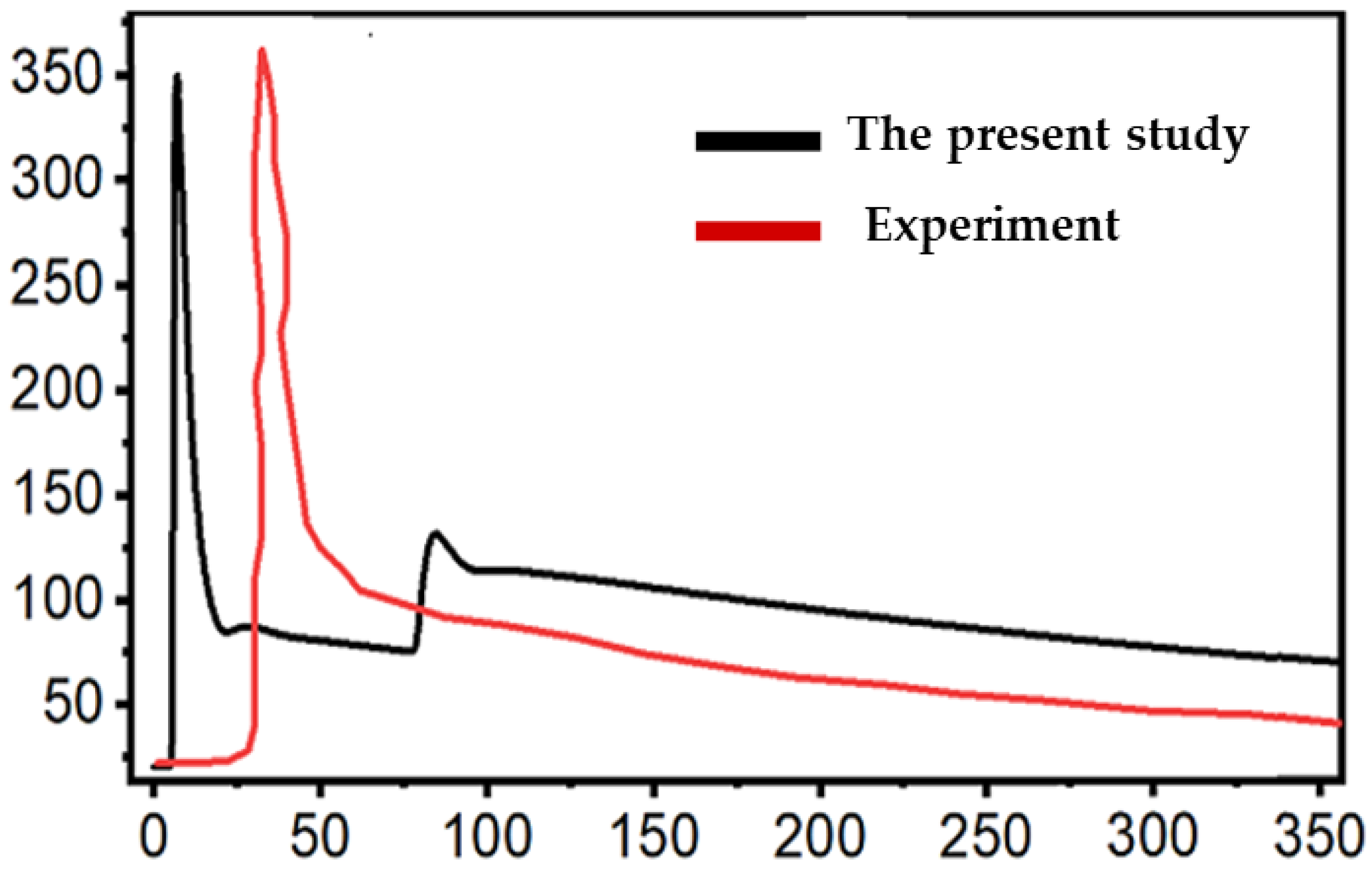
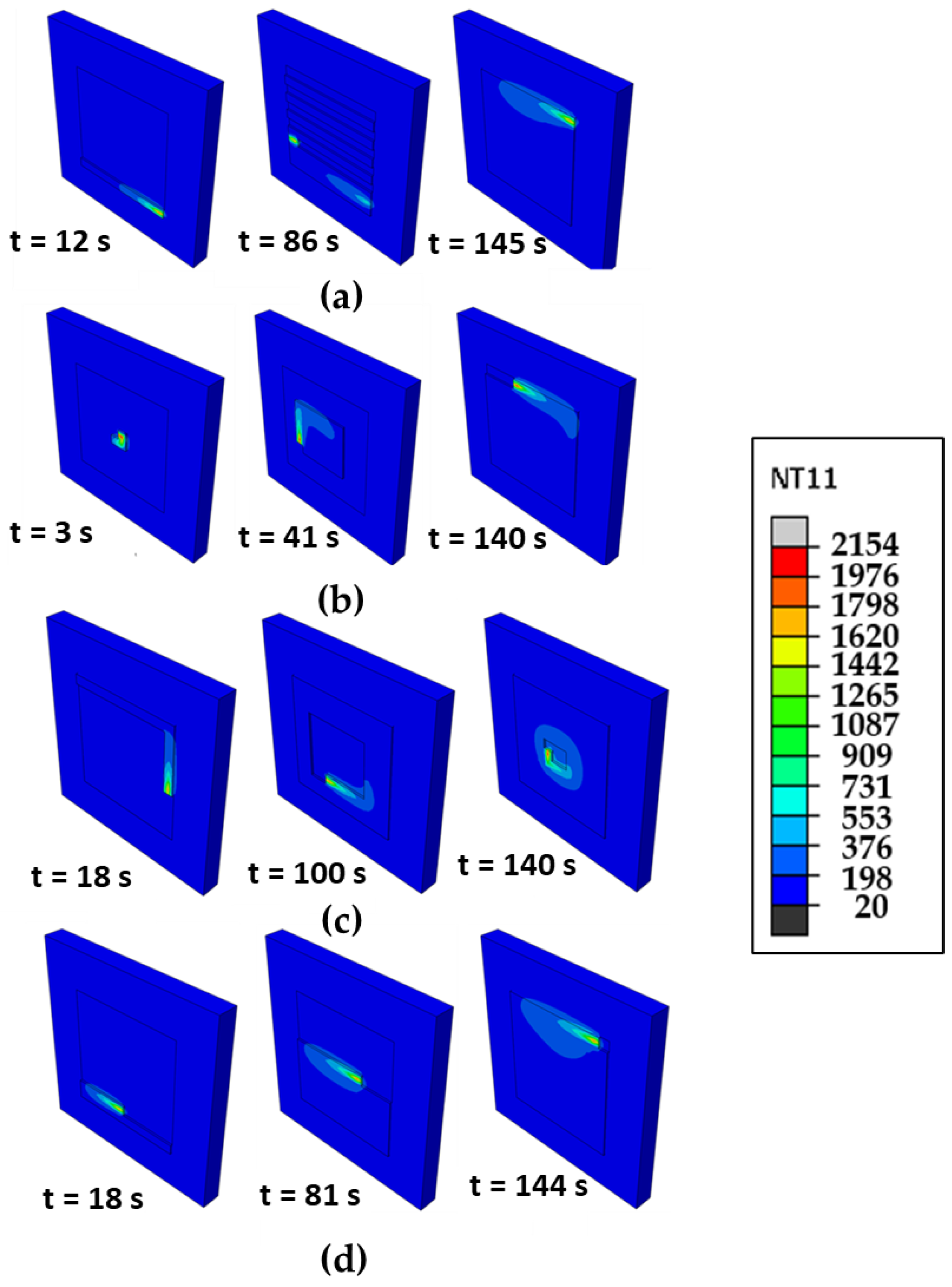

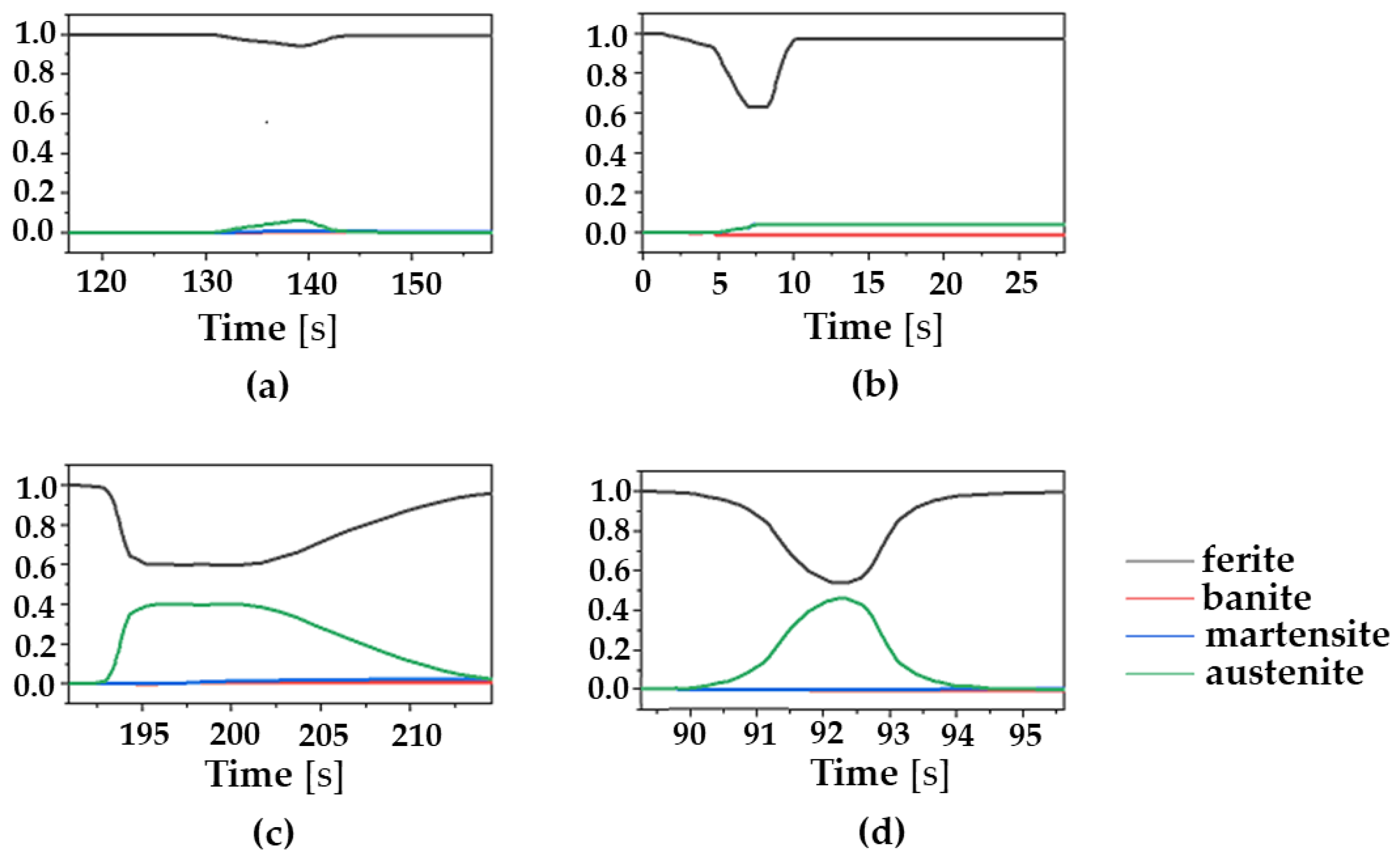
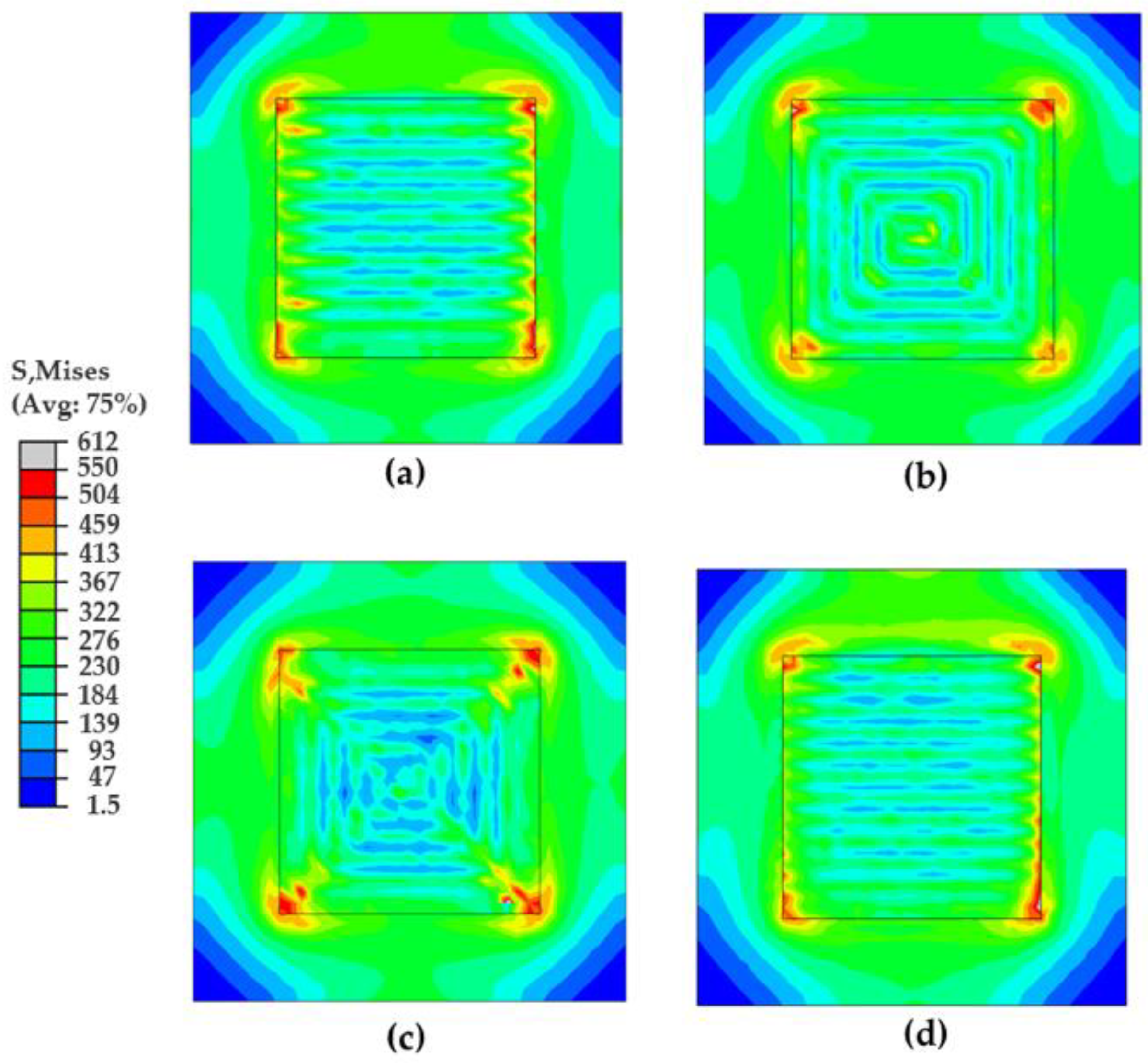

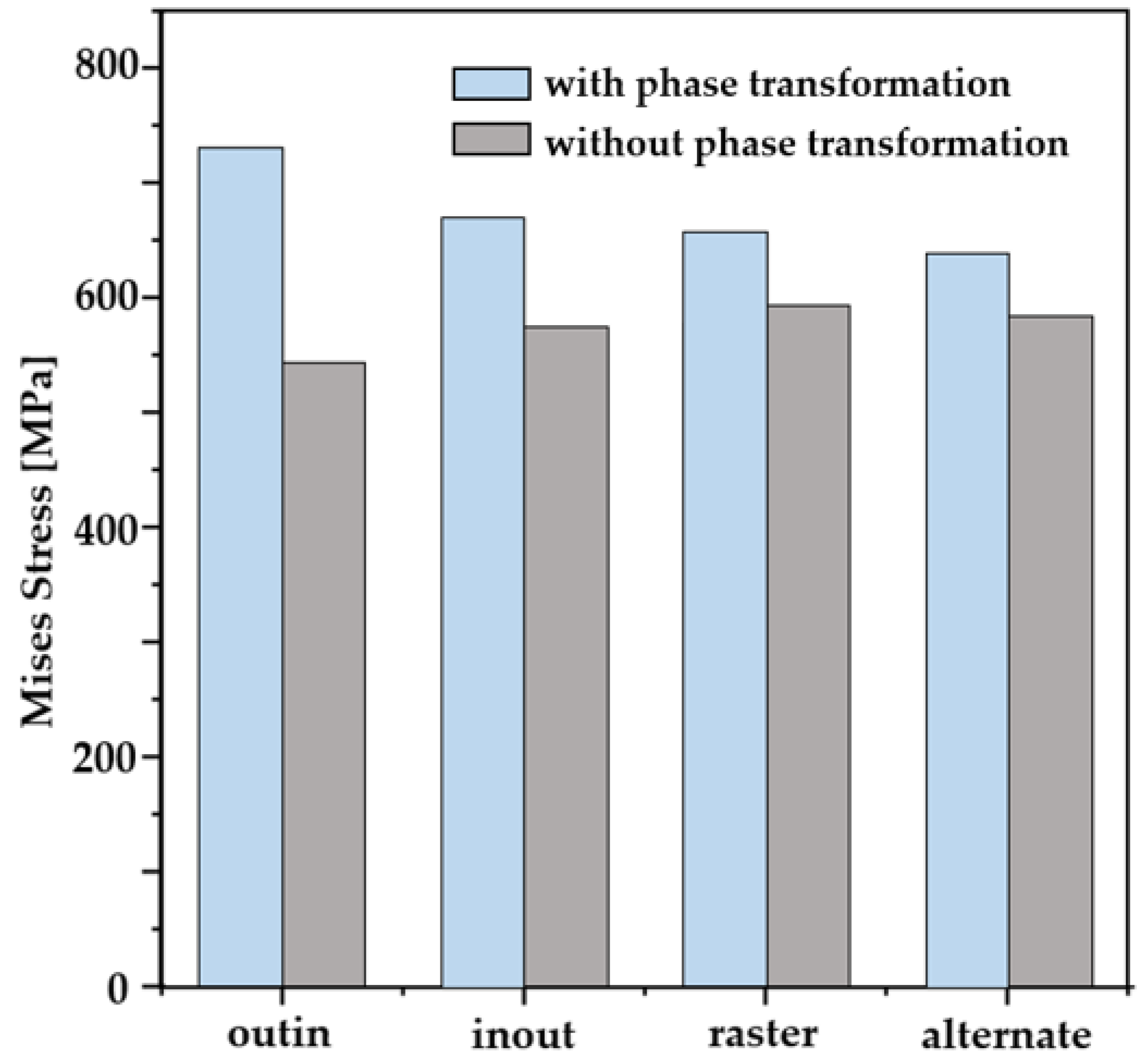

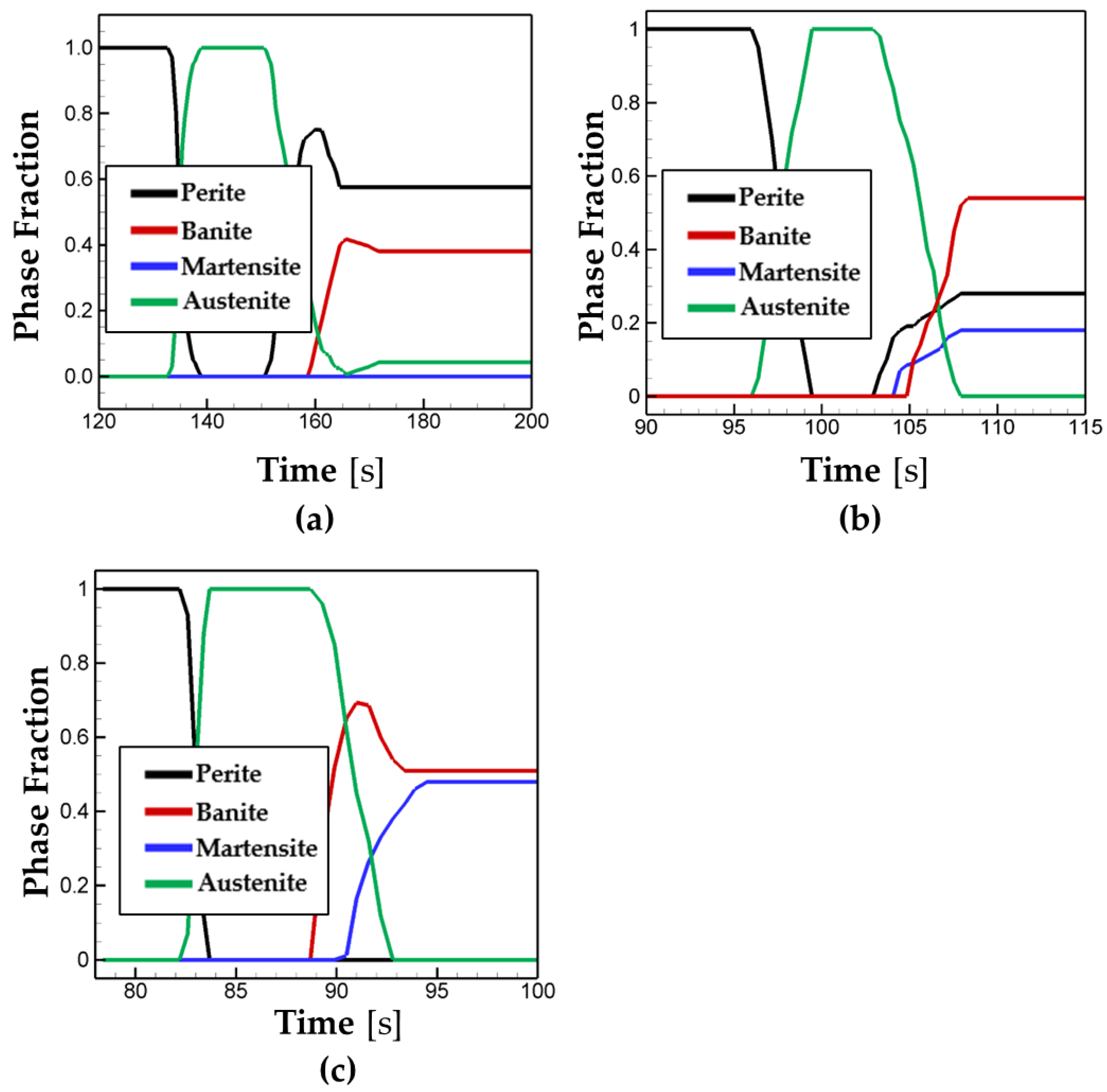
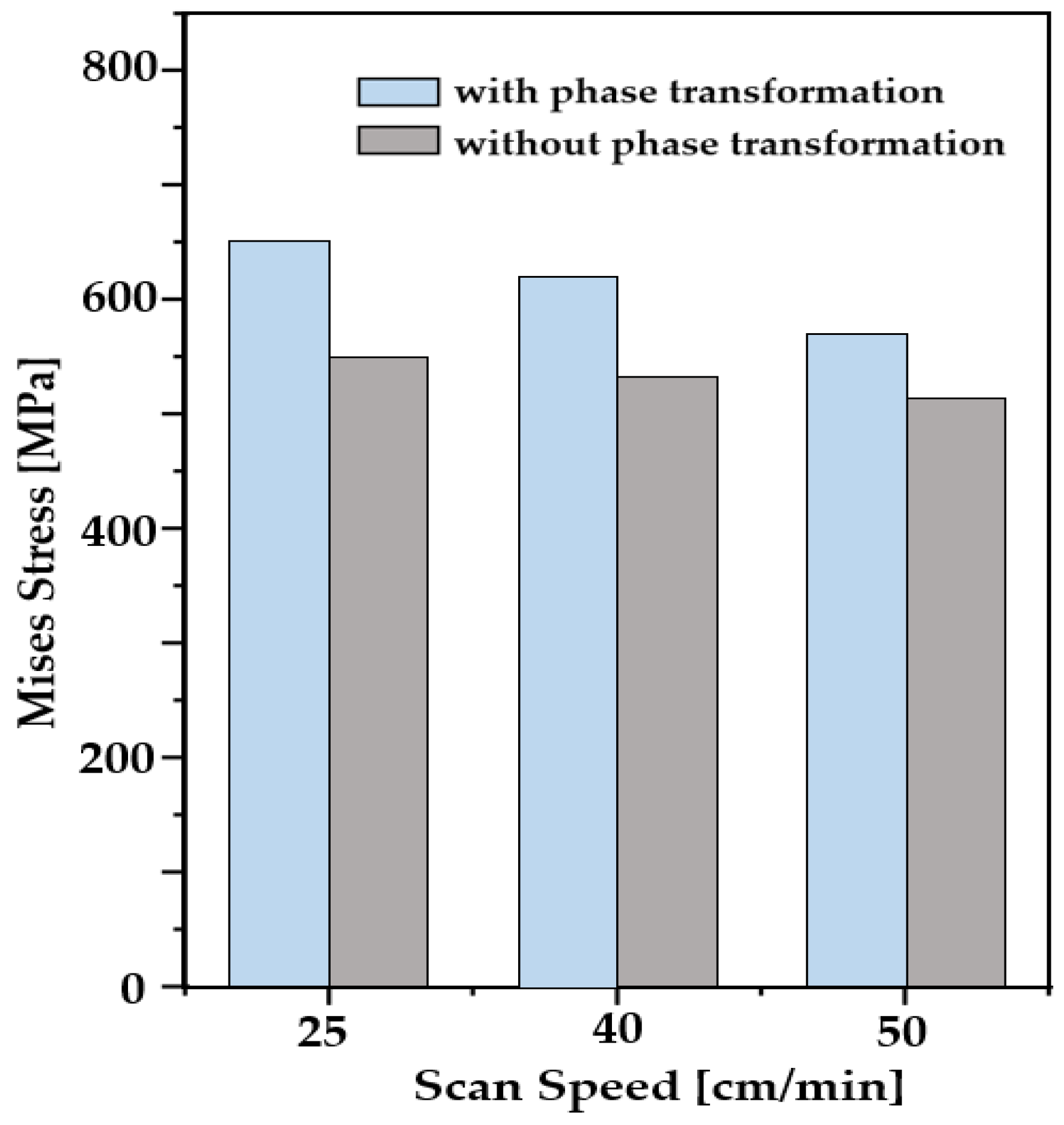
| (mm) | (mm) | (mm) | (mm) | (W) | ||
|---|---|---|---|---|---|---|
| 5 | 10 | 3.35 | 5 | 0.6 | 1.4 | 7258 |
| Cooling Rate (°C/s) | Ferritic Transformation | Banitic Transformation | ||||
|---|---|---|---|---|---|---|
| Ts (°C) | Tf (°C) | τ (s) | Ts (°C) | Tf (°C) | τ (s) | |
| −0.98 | 699.8 | 581.2 | 0.95 | 581.2 | 508.0 | 0.001 |
| −1.74 | 689.0 | 570.4 | 0.001 | 570.4 | 501.2 | 0.001 |
| −2.58 | 678.9 | 567.8 | 0.01 | 567.8 | 494.2 | 0.001 |
| −5.08 | 651.2 | 562.2 | 0.007 | 562.2 | 484.0 | 0.001 |
| −10.71 | 624.1 | 555.5 | 0.9775 | 555.5 | 461.7 | 0.005 |
| −16.72 | 612.7 | 545.8 | 1.05 | 545.8 | 446.3 | 0.01 |
| −20.46 | 603.3 | 550.1 | 1.95 | 550.1 | 424.2 | 0.001 |
| −29.35 | 587.8 | 546.7 | 1.8 | 546.7 | 454.3 | 0.44 |
| −41.67 | 567.9 | 543.7 | 1.055 | 543.7 | 452.0 | 0.91 |
| −65.29 | No ferritic transformation occurs | 537.0 | 448.9 | 0.787 | ||
| −84.39 | 526.4 | 451.1 | 1.82 | |||
| Temperature (°C) | Thermal Conductivity (W/(m°C)) | Density (kg/m3) | Young’s Modulus (GPa) | Thermal Expansion Coefficient (10−6/°C) | Specific Heat (J/g°C) | Poisson Ratio |
|---|---|---|---|---|---|---|
| 25 | 45.87 | 7851 | 208.6 | 12.48 | 0.435 | 0.289 |
| 100 | 45.83 | 7837 | 204.3 | 12.88 | 0.454 | 0.292 |
| 200 | 45.08 | 7813 | 199.5 | 12.90 | 0.497 | 0.294 |
| 300 | 43.13 | 7755 | 189.9 | 13.37 | 0.554 | 0.300 |
| 400 | 40.83 | 7726 | 181.6 | 13.89 | 0.605 | 0.307 |
| 500 | 37.88 | 7696 | 168.4 | 14.36 | 0.660 | 0.308 |
| 600 | 35.13 | 7664 | 156.3 | 13.65 | 0.768 | 0.311 |
| 700 | 32.50 | 7622 | 136.8 | 13.86 | 0.962 | 0.317 |
| 800 | 29.55 | 7599 | 125.6 | 15.26 | 0.920 | 0.327 |
| 900 | 27.65 | 7560 | 112.8 | 15.44 | 0.651 | 0.347 |
| 1000 | 28.87 | 7531 | 102.6 | 15.65 | 0.605 | 0.354 |
| 1100 | 30.05 | 7500 | 92.2 | 15.74 | 0.624 | 0.359 |
| 1200 | 31.37 | 7452 | 83.0 | 16.05 | 0.624 | 0.364 |
| 1300 | 32.55 | 7394 | 43.1 | 16.32 | 0.647 | 0.370 |
| 1400 | 33.69 | 7340 | 16.62 | 0.663 | 0.378 |
Disclaimer/Publisher’s Note: The statements, opinions and data contained in all publications are solely those of the individual author(s) and contributor(s) and not of MDPI and/or the editor(s). MDPI and/or the editor(s) disclaim responsibility for any injury to people or property resulting from any ideas, methods, instructions or products referred to in the content. |
© 2023 by the author. Licensee MDPI, Basel, Switzerland. This article is an open access article distributed under the terms and conditions of the Creative Commons Attribution (CC BY) license (https://creativecommons.org/licenses/by/4.0/).
Share and Cite
Han, Y.S. Wire Arc Additive Manufacturing: A Study of Process Parameters Using Multiphysics Simulations. Materials 2023, 16, 7267. https://doi.org/10.3390/ma16237267
Han YS. Wire Arc Additive Manufacturing: A Study of Process Parameters Using Multiphysics Simulations. Materials. 2023; 16(23):7267. https://doi.org/10.3390/ma16237267
Chicago/Turabian StyleHan, You Sung. 2023. "Wire Arc Additive Manufacturing: A Study of Process Parameters Using Multiphysics Simulations" Materials 16, no. 23: 7267. https://doi.org/10.3390/ma16237267
APA StyleHan, Y. S. (2023). Wire Arc Additive Manufacturing: A Study of Process Parameters Using Multiphysics Simulations. Materials, 16(23), 7267. https://doi.org/10.3390/ma16237267




